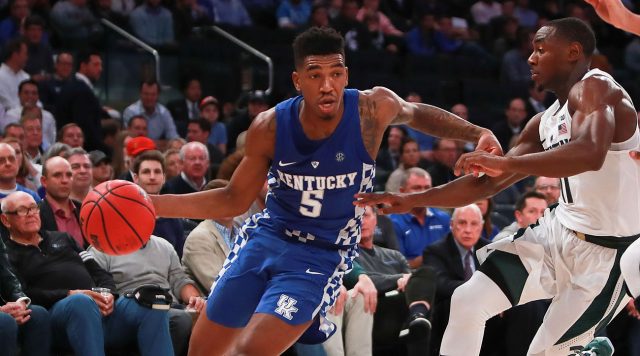
How Does NCAAB Betting Volume Change After Football Season?
When it comes to the sports betting marketplace, there’s no question that football is king. According to the UNLV Center for Gaming Research, Las Vegas sportsbooks make nearly half of their revenue from football bettors despite the comparatively short season. From 1992 to 2016, $28.3 billion was wagered on football as compared to $18.4 billion on basketball and $14.0 billion on baseball. If the handle from offshore sportsbooks was included, that number would be even more staggering.
With football season in the rearview, many bettors cash out with their bookie or sportsbook as they eagerly await the following season. However, most bettors turn their attention to basketball — especially when the NCAA Tournament rolls around. Following the conclusion of the football season, “college basketball betting increases at around a 25 percent clip,” according to Scott Cooley, a spokesman for Bookmaker.eu. Since the value of betting against the public is directly correlated with the number of bets placed on each game, I wanted to see whether our records confirmed Cooley’s statement.
Using our historical database, which goes back to 2005, I found that the number of bets per game steadily increases as the season progresses. The number of bets placed is tracked on our live odds page and represents the total number of bets placed at 5Dimes and CaribSports only.
The table below displays the average number of bets placed on each college basketball game by month.
| Month | Average Tickets/Game |
|---|---|
| November | 2,867 |
| December | 3,728 |
| January | 3,853 |
| February | 4,729 |
| March | 9,571 |
| April | 32,724 |
As you can see, the average number of bets placed is fairly low in November, December, and January when bettors are preoccupied with the ongoing football season. In fact, our numbers confirm Cooley’s assessment, as the average number of bets increases by just under 25% between January and February. The number of bets then doubles between February and March. That increase in volume is particularly impressive when you consider that there are many smaller tournaments (like the NIT, CIT, and CBI) which limit that average. In fact, the average number of bets during the NCAA Tournament is nearly 30,000!
“Public betting has very little impact on the college basketball oddsmaking landscape, particularly early in the season when the majority of our handle is from sharper players,” according to Cooley. “There is certainly more public volume for college basketball [after football season ends], but that doesn’t really change the way we adjust lines. There are circumstances where we have a Duke vs. UNC matchup and the sharps aren’t involved, we will adjust there for public money if we have liability on one side.”
In other words, sportsbooks almost always adjust their lines based on the action of their sharpest bettors, and they won’t move the number based on public money unless there’s a marquee matchup with one-sided public betting and limited sharp action on the other side. There are many factors to consider when betting against the public, but the ticket count is consistently one of the most crucial.
Since 2005, teams receiving less than 25% of spread bets have gone 1,393-1,284 ATS (52%) in heavily bet games but only 1,683-1,735 ATS (49.2%) in all other games. That trend has continued this season, but it’s also worth noting the historical value of this strategy during March Madness. Although it’s a smaller sample, teams receiving less than 25% of spread bets have gone 33-19 ATS (63.5%) in the NCAA Tournament and 67-56 ATS (54.5%) in the six major conference tournaments (ACC, Big East, Big Ten, Big 12, Pac-12 and SEC).
There are relatively few square bettors early in the college basketball regular season, so oddsmakers will usually adjust their lines based on sharp action. It’s only in the most heavily bet games featuring extremely lopsided public betting that you can find value going against the grain. With football season over and more casual bettors jumping into college basketball, there’s additional value betting against the public in these later months.
It’s also important to realize that public money isn’t necessarily causing the line to move. Sportsbooks know which teams will receive the majority of public money before posting the opener, so they shade their opening lines to capitalize on public perception. Since oddsmakers can accurately anticipate one-sided action from public bettors, they react by shading lines to force these bettors to take bad numbers when playing the popular side of a game. This shading creates added value for bettors willing to go against the grain and fade the public.
The number of bets statistic is proprietary Sports Insights information that is available exclusively to Sportsbook Insider subscribers. Sign up for a 4-day Pro trial and you will also receive real-time odds, public betting trends, money percentages, e-mail alerts, our in-house Best Bet picks and much more.
Have any questions for the staff at Sports Insights? Utilize our live chat to speak with a customer service representative or e-mail us at help@sportsinsights.com.

No Comments